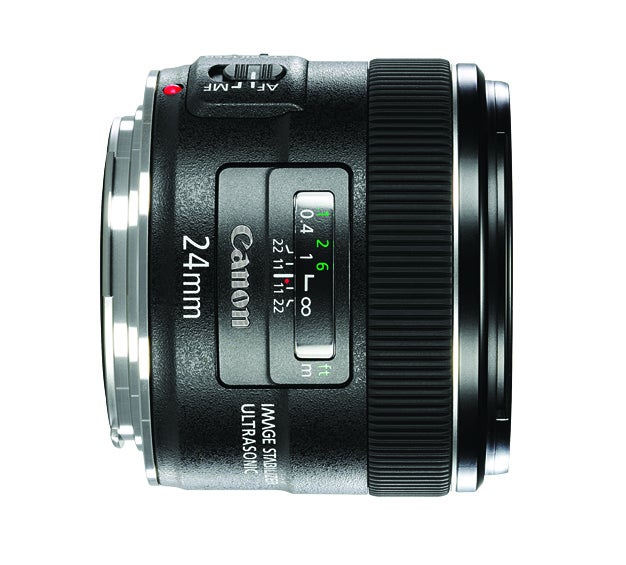Lens Test: Canon EF 24mm f/2.8 IS USM
The world's widest stabilized prime is sharp and unsharp in just the right places

We may earn revenue from the products available on this page and participate in affiliate programs. Learn more ›
The widest of Canon’s recent barrage of wide-angle, full-frame prime lenses, this 24mm f/2.8 IS USM ($807, street)—along with the 28mm f/2.8, and new 35mm f/2—forms a three-tiered team, notable for compact proportions, reasonable pricing, and image stabilization across the board. Significantly lighter and more compact than Canon’s com-parable nonstabilized f/1.4 primes, all three newcomers are also far less expensive.
This 24mm f/2.8 replaces Canon’s nonstabilized 24mm f/2.8 EF, which was introduced in November 1988, just over a year after the birth of the company’s now-venerable EOS system. It boasts a molded-glass aspherical rear lens element for edge-to-edge contrast and sharpness, full-time manual focus, and a number of advances over the old lens, including Canon’s sophisticated ring-type USM focusing motor and the aforementioned stabilization.
At just over 10 ounces, this new prime is pleasingly light and compact, and takes 58mm filters. Its attractive matte-black surfacing is adorned with faint stippling. There’s a welcome depth-of-field scale for f/11 through f/22, but you have to pay extra if you want a lens shade—and we highly recommend the use of one for ultrawides like this one.
Autofocus action is extremely fast and quiet, and manual focus has a smooth, even, well-damped turn with a generous 110-degree radius. In the field, the lens feels and handles like a classic 50mm f/1.8, albeit twice as wide.
On our optical bench in the Popular Photography Test Lab, the lens produced Excellent SQF results for sharpness and contrast that were just slightly below those of Canon’s pro-level 24mm f/1.4L.
Our distortion tests using DxO Analyzer 4.1 found Visible (0.33%) barreling—less impressive than the f/1.4L, which showed Slight (0.16%) barrel distortion. While these numbers might seem slightly damning, the 24mm f/2.8 matched or did considerably better than most of today’s popular 24–70mm f/2.8 zooms at 24mm by most of the usual optical standards.
This lens stands out as far less bulky and much less costly than higher-speed options. Also, since wide-angle images appear sharper by their nature, the added IS makes hand-holding at truly slow shutter speeds a realilty; our tests found an extra 2 stops of leeway. Using the usual reciprocal-of-the-focal-length rule, this means that average shooters should be able to shoot at 1/6 sec rather than 1/25 and attain acceptably sharp pictures of stationary subjects.
With its compact, perfect-for-travel size, responsiveness, and relatively low price, Canon’s stabilized 24mm f/2.8 —great for low-light and tight interiors—should make a nice high-speed, wide-angle option for amateurs and pros alike. Even without a lens shade.
SPECIFICATIONS
24mm (25.55mm tested), f/2.8 (f/2.96 tested), 11 elements in 9 groups. Focus ring turns 110 degrees.
Diagonal View Angle: 84 degrees.
Weight: 0.66 lbs. Filter size: 58mm.
Mounts: Canon AF.
Street Price: $807.
Website: canonusa.com
TEST RESULTS
Distortion: 0.33% (Visible) barrel.
Light Falloff: Gone by f/5.6.
Close-focusing Distance: 7.63 inches.
Maximum Magnification Ratio: 1:3.91.
Image Stabilization: 2 stops.
